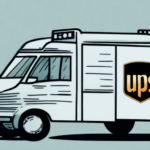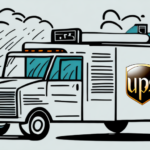What Is the UPS Additional Handling Fee?
If you frequently ship packages using UPS, you may have come across the term "additional handling fee." This fee is an extra charge that UPS imposes on packages requiring special handling during shipment. In this article, we'll explore everything you need to know about the UPS additional handling fee to help you understand it better and avoid paying it unnecessarily.
Understanding the Different Types of UPS Fees
Before delving into the specifics of the UPS additional handling fee, it's essential to understand the various fees that UPS charges its customers. UPS, like any other shipping carrier, offers several shipping options, each with different rates and fees. Some of the standard UPS fees include:
- Base Shipping Fee: The cost of shipping a package from one location to another. This fee varies based on the package's weight, size, and the distance it needs to travel.
- Delivery Area Surcharge: An additional fee charged for delivering packages to certain areas, such as remote or rural locations.
- Address Corrections: Fees imposed when a package is shipped to an incorrect or incomplete address. To avoid this fee, ensure that the correct address is entered when shipping.
- Declared Value: An optional service allowing customers to declare the value of their package. This fee is based on the declared value and determines the amount of insurance coverage provided.
- Insurance: Coverage for lost or damaged packages beyond the standard liability.
- Oversize Package Fees: Charges for packages that exceed UPS’s standard size and weight limits.
- Additional Handling Fees: Extra charges for packages requiring special handling due to size, weight, shape, or other factors.
Understanding these fees can help you plan your shipments more effectively and avoid unexpected costs.
What Triggers the Additional Handling Fee?
The UPS additional handling fee is imposed on packages requiring special handling due to their size, shape, weight, or other characteristics. These packages can be challenging to handle, process, and move during transit. Factors that could trigger the UPS additional handling fee include:
- Packages weighing over 70 pounds
- Packages measuring over 48 inches on the longest side
- Packages with irregular shapes that make them difficult to stack or handle
- Packages requiring special equipment to load and unload
- Packages not fully encased in corrugated cardboard
- Fragile items
- Hazardous materials
- Packages with special handling requirements
It's important to note that the UPS additional handling fee is not limited to the factors listed above. Other characteristics like package fragility or hazardous contents can trigger the fee. For a comprehensive list of factors, it's recommended to check with UPS directly or visit their official fees page.
Factors That Affect the UPS Additional Handling Fee
Several variables determine the amount of the UPS additional handling fee. These include the package's dimensions, weight, and shipping destination. Generally, the more oversized or heavier the package, the higher the additional handling fee.
Package Dimensions and Weight
The size and weight of your package are primary factors influencing the additional handling fee. Larger and heavier packages require more effort and resources to manage, thus incurring higher fees.
Type of Item Shipped
The nature of the item being shipped also plays a role. Fragile or oddly shaped items may require special handling, resulting in a higher fee. Additionally, packages needing extra labeling or documentation may incur additional charges.
Carefully considering these factors when shipping with UPS can help you avoid unexpected fees.
How Much Is the UPS Additional Handling Fee?
The UPS additional handling fee varies based on the factors discussed above. As of 2023, the standard UPS additional handling fee is approximately $25 per package for domestic shipments. International shipments may incur higher fees based on the destination country and other factors.
It's important to note that the UPS additional handling fee can also vary depending on the size and weight of the package. For example, if your package exceeds UPS's maximum weight or size limits, you may be charged an additional fee. Moreover, if your package requires special handling due to its fragility or shape, you may also incur an extra fee.
For the most accurate and up-to-date information, it's always advisable to check with UPS or your shipping provider to understand all potential fees and charges associated with your shipment.
How to Avoid Paying the UPS Additional Handling Fee
The best way to avoid the UPS additional handling fee is to ensure that your package meets UPS's size and weight guidelines. Here are some strategies:
- Optimize Package Size: If you're sending something heavy, consider breaking it down into smaller packages, each under 70 pounds, to avoid incurring additional handling fees.
- Proper Packaging: Ensure that your package is properly packaged and complies with UPS's shipping guidelines. Using corrugated cardboard to protect your package can minimize the chances of paying additional handling fees.
- Utilize UPS Online Tools: Use UPS's online shipping tools to calculate the cost of your shipment and select the appropriate shipping method. Choosing the right shipping method can help you avoid additional handling fees and save money.
- Accurate Weight and Size Measurements: Ensure that the weight and dimensions you provide are accurate to prevent unexpected fees.
The Impact of the UPS Additional Handling Fee on Small Businesses
The UPS additional handling fee can be a significant cost for small businesses that frequently ship larger items. This fee can significantly increase the total shipping cost and eat into the profit margin of businesses. Therefore, it's essential for businesses to plan accordingly and avoid incurring unnecessary fees.
Optimizing Packaging
One way small businesses can avoid the UPS additional handling fee is by optimizing their packaging. By using appropriate packaging materials and ensuring that the dimensions of the package are within UPS's guidelines, businesses can avoid the additional handling fee.
Considering Alternative Shipping Carriers
Additionally, businesses can consider using alternative shipping carriers that may offer lower fees for larger items. Carefully evaluating shipping options and costs helps small businesses maximize their profits.
Tips for Reducing Shipping Costs with UPS
To reduce your shipping costs with UPS, consider the following tips:
- Negotiate Discounted Rates: If you are a high-volume shipper, negotiate discounted rates with UPS.
- Explore Alternative Shipping Carriers: Consider using alternative shipping carriers like FedEx or USPS, which could offer better rates and more flexible shipping options.
- Optimize Packaging: Use the smallest box possible for your shipment and avoid excessive packaging materials. This not only reduces shipping costs but also helps the environment by minimizing waste.
- Leverage UPS Online Tools: Utilize UPS's online tools and resources such as shipping calculators, rate charts, and shipping guides to find the most cost-effective shipping options for your business.
Other Common Shipping Fees Charged by UPS
In addition to the additional handling fee, UPS charges several other fees. Some of these include:
- Oversized Package Fees
- Delivery Area Surcharges
- Address Correction Fees
- Peak Season Surcharges
- Declared Value Fees
- Signature Confirmation Fees
- Saturday Delivery Fees
Another common fee is the Declared Value Fee. This fee is based on the value of the item being shipped and covers the cost of insuring the package. UPS also offers additional services such as signature confirmation and Saturday delivery, which come with their own fees. Reviewing all available options and associated fees is crucial to determine the best shipping method for your needs.
Comparing Shipping Costs with Different Carriers: UPS vs FedEx vs USPS
To ensure you're getting the best shipping rates, compare shipping costs across different carriers like UPS, FedEx, and USPS. Each carrier has its strengths and weaknesses and offers different rates and shipping options. Therefore, it's crucial to shop around and choose the carrier that best fits your budget and shipping needs.
Considerations When Comparing Shipping Costs
- Package Size and Weight: Some carriers may offer better rates for smaller packages, while others may have better rates for larger packages.
- Bulk Shipping Discounts: Some carriers offer discounts for bulk shipping or for using their online shipping tools.
- Delivery Time: Consider the delivery time options. Some carriers may offer faster delivery at a higher cost, while others may have slower delivery times but lower rates.
Balancing cost and delivery time ensures that your package arrives on time and within your budget.
Conclusion
The UPS additional handling fee is a real cost that can significantly increase your shipping expenses. By understanding what triggers it and how to avoid it, you can minimize its impact and save money on shipping costs. Remember to package your items correctly and consider alternative shipping carriers to find the best rates.
It's important to note that the UPS additional handling fee is not the only extra cost you may encounter when shipping items. Other fees, such as fuel surcharges and residential delivery fees, can also add up quickly. To avoid surprises, make sure to read the carrier's fee schedule carefully and factor in all potential costs when calculating your shipping expenses. Additionally, consider negotiating rates with your carrier or using a third-party shipping service to help you save money on shipping costs.








